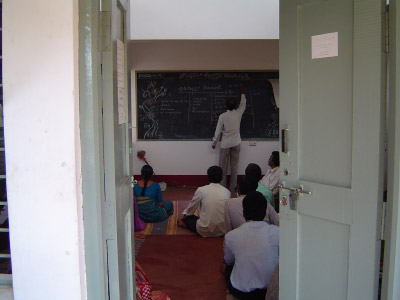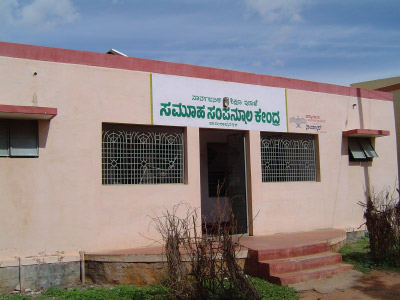Contribute
| Work An Hour (WAH) 2005: Asha For Education Program |
Melli Annamalai
08/25/2005
“What is the difference between a lens and a mirror?â€, asked a teacher. I was attending a teacher training session for government school teachers in Chamarajanagar district and I was startled by the question. The teachers had come from various village government schools to Chamarajanagar town for training. Lenses, mirrors, and the associated laws of Physics are introduced in class VII, and the training session was to help the teachers teach the material better. During such sessions teachers become students, and are trained by someone called a resource person, who is considered knowledgeable in that subject area. I was attending this particular session to observe and learn about the problems in government schools in the area. Experiments were being demonstrated to show the concepts of focal length, and convergence and divergence of light rays. I wondered to myself - how can these experiments make sense, and how will the teachers use them if basic concepts such as the difference between a lens and a mirror was not clear? "What is the principle behind one-way glass?" asked another teacher, referring to the new advertisements being painted on bus windows. People on the inside could see out, but people on the outside could not see in. The trainer did not know the answer and neither did I. "If ocean waves are caused by the wind, why are waves only in one direction?" was another question neither the trainer nor I could answer. I could not help but be impressed at the questions raised by the teachers. They were eager to learn. But how will they Chamarajanagar district, in the southern region of the state of Karnataka, has one of the lowest literacy rates in the state (50.9% for males and 42.5% for females). The dropout rates are high after middle school, and pass percentage in class X in some areas is in single digits. The Asha-MIT/Boston chapter has been working to improve government schools in the area for the last three years. In those three years along with our project partner in India we have studied the various issues that affect government schools – infrastructure, teachers, involvement of the village education committees. In rural schools in this district, we felt that the problem is not the commonly talked about So when NIAS (The National Institute of Advanced Studies) came along with a proposal to refurbish the resource centers in the area, we were excited. Their work nicely complemented our work in the area government schools in the last 3 years. NIAS had a team of educationists working in Chamarajanagar district. They had spent a year analyzing the problem, and came to the conclusion that the teacher training component was one of the areas that needed strengthening. The NIAS team believed that the training programs could be strengthened by improving various processes that had already been put in place by the government, and by focusing on the training of the trainers. As with many government schemes, the processes where in place, but functioned poorly in reality. NIAS's goal was to improve these processes, and by doing so not only utilize the vast government infrastructure and machinery already in place, but also contribute towards a permanent solution. Improving existing government processes is a more permanent solution than external efforts by non-governmental organizations that have to be sustained by a regular external funding. NIAS requested $12,000 to refurbish 3 Chamarajanagar resource centers for teachers. The 3 resource centers will together serve the needs of teachers of about a 100 schools. Each resource center serves a cluster of schools, typically around 30 within a 20km radius. The structure (4 walls and a roof) of these centers exists, but there is nothing in them. The doors and windows are broken, and the room is unfit for use as a resource center. Asha MIT/Boston will collaborate with NIAS to repair the center, whitewash it and make it a usable room. When I visited last month, this had already been done for one resource center and was already being used for training for the EDUSAT programs (recently launched government educational programs via satellite TV in all schools in Chamarajanagar district). The funds will also be used for reference books, teaching aids to teach arithmetic, geometry and geography, charts and display boards, and raw materials to make teaching aids with. All this will be stored at the center. Because providing teaching aids to each and every school would be expensive, these are provided at the center and the teachers can borrow them for use at their schools. In addition to providing a space for training programs and a space for storage of materials, the idea of the center is to provide a space for teachers to meet, conduct discussions. A space for the teachers to meet is sorely needed, for example to help the teacher from the village of Ethaegowdanahundi share the wonderful innovations he had come up with to teach the fact that multiplication is repeated addition. The resource center is also a space for administrators to use it for any activity that will facilitate education in the area. At Asha-MIT/Boston, we believe that education is not a question of just teaching the 3 Rs. Education is understanding and appreciating the millions of concepts in this world, and importantly, learning how to learn. This cannot be done by textbooks alone. Access to information, to materials, to resource people, is needed. We hope to contribute to the improvement of education in Chamarajanagar district through this year's Work an Hour. More details of the project are available at http://www.workanhour.com/projects/nias/ and you can follow the ‘Donate’ link to participate in this year’s Work an Hour and contribute to this project.
learn? The trainers do not necessarily know much more. There is no google they can access to get answers. Chamarajanagar town does not have anything that could be called a good library, forget having access to books at the village schools themselves. The nearest library with books that might help in answering some of these questions is probably the University of Mysore library, about 2 hours by bus from Chamarajanagar town. The only resources available for teachers were the poorly written textbooks complete with factual and grammatical errors. When new concepts are introduced into the syllabus, it is a real challenge to first understand the material, and then teach it. Is it any wonder that only a handful of students make it past high school?
teacher absenteeism, poor infrastructure, poor teacher-student ratio, and so on. True, there was some teacher absenteeism. True, there were only 3-4 rooms in upper primary schools for seven classes (classes I to VII) which meant either having multi-grade classes or conducting classes in the corridor outside. But by and large the infrastructure was not too bad, the teachers were sincere, and the teacher-student ratio was relatively good. What then was the problem? We felt that one major component was the lack of resources for the teachers. They have nowhere to go when they have questions. They have no easy access to books, to material that will help them teach, and to help them conduct simple experiments to illustrate the laws of light and the laws of motion. More importantly, they have no access to resources to teach them how to make these tools themselves, from locally available materials. The teachers have by and large graduated from schools in the area, and the poor quality of learning they have had contributed to the poor quality of their teaching. The problem was cyclic, and this cycle had to be broken somehow.
By Melli Annamalai
Asha MIT/Boston
You may also access this article through our web-site http://www.lokvani.com/

